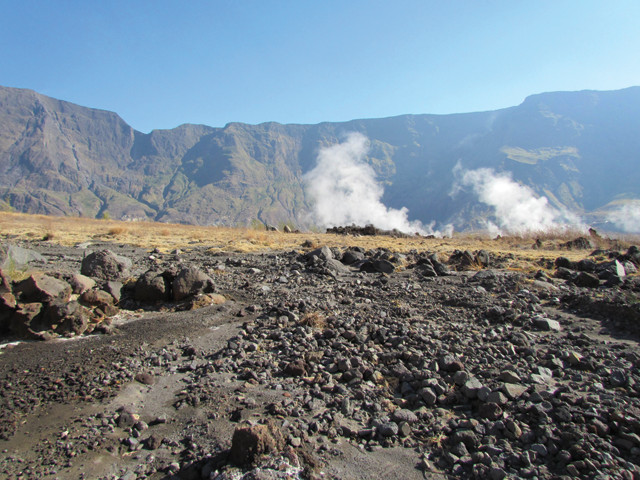
by Adityarup "Rup" Chakravorty Tuesday, August 16, 2016

Steam and gas rise from the caldera floor of Mount Tambora in Indonesia. New research may explain why some volcanic eruptions, such as Tambora's 1815 eruption, are so explosive and emit large amounts of sulfur gases. Credit: Georesearch Volcanedo Germany, CC BY-SA 3.0.
The spectacular 1815 eruption of Indonesia’s Mount Tambora spewed large amounts of sulfur gases into the atmosphere, which formed fine sulfur-rich particles that blocked sunlight and lowered global temperatures by more than half a degree Celsius, causing famine and death on a global scale.
Magma is known to contain large volumes of gases, but how do some volcanic eruptions, like the 1815 Tambora eruption, become so explosive and emit large amounts of sulfur? According to a recent study in Nature, the answer may lie in previously unrecognized accumulations of bubbles — containing mixtures of water vapor, carbon dioxide, sulfur gases and other volatiles — in magma chambers below Earth’s surface.
“Magma chambers in the shallow crust — between 5 and 10 kilometers below Earth’s surface — are the staging grounds for volcanic eruptions,” says Olivier Bachmann, a volcanologist at ETH Zürich in Switzerland and an author of the study. The lower portions of these magma chambers are rich in crystals, while the upper parts commonly contain crystal-poor melt. Vapor bubbles should seemingly get trapped in narrow channels within the crystal-rich zone, Bachmann and his colleagues noted, with the bubbles’ innate tendency to rise blocked by both the crystals and the highly viscous magma that fills the gaps between crystals.
Instead, it seems that “the vapor bubbles actually travel more quickly through the crystal-rich parts of magma chambers than through the crystal-poor melt,” says lead author Andrea Parmigiani, also at ETH Zürich. “It’s a bit counterintuitive.”
Parmigiani, Bachmann and colleagues at Georgia Tech in Atlanta developed computer models that simulated the fluid dynamics of magma chambers with distinct crystal-rich and crystal-poor layers. They observed that individual vapor bubbles can join together to form winding, spaghetti-like channels that squeeze between crystals and allow volatile compounds to travel upward relatively quickly.
“When these fingers of vapor reach the boundary between the crystal-rich and crystal-poor zones, they snap off into individual bubbles again,” Parmigiani says. Beyond this boundary, the individual bubbles then begin rising through viscous magma by themselves. As they migrate upward slowly, the wake from each individual bubble’s journey slows down its neighbors, resulting in conglomerations of vapor-filled bubbles traveling slowly through the magma chamber to collect near its ceiling.
The team hypothesizes that as gas bubbles accumulate, the pressure within a magma chamber increases. Ultimately, the pressure could cause violent eruptions and — as in the case of Mount Tambora — the release of large amounts of volatiles, including sulfur compounds, water vapor and carbon dioxide, into the atmosphere.
The researchers also conducted laboratory experiments to verify their simulations, observing the behavior of streams of water droplets rising through silicon oil; the difference in viscosity between the water and oil mimicked that between vapor bubbles and magma. They found that the water bubbles indeed coalesced into clusters as they traveled through the oil, supporting their vapor bubble migration model.
“This model provides a new explanation for how bubbles of gas may rise quickly through crystal-rich magma but then become trapped and concentrated in the crystal-poor magma higher up in the crust,” says David Pyle, a volcanologist at Oxford University in England who was not involved in the study.
“The laboratory results and computer simulations are pleasingly consistent, which shows that the computer model is working well,” Pyle says. He notes that the authors made some simplifying assumptions in order to run the computer simulations, such as that the vapor and liquid phases never mixed with each other. But simulations like these are difficult to run, he says, and “by keeping them as simple as possible, while also trying to keep them relevant to the real world, the authors have helped explain a rather complicated phenomenon.”
Pyle says the new study “demonstrates that computational approaches can help develop and test new ideas about how complicated physical systems, like magmas, behave, and will prompt volcanologists … to think about what the geological fingerprint of this process might look like.” The challenge, he says, when applying these simulations to the real world is that models need to become more complex. “For example, they have to account for how the amounts of vapor inside the bubbles in magma chambers will depend on pressure, temperature and magma composition.”
© 2008-2021. All rights reserved. Any copying, redistribution or retransmission of any of the contents of this service without the expressed written permission of the American Geosciences Institute is expressly prohibited. Click here for all copyright requests.